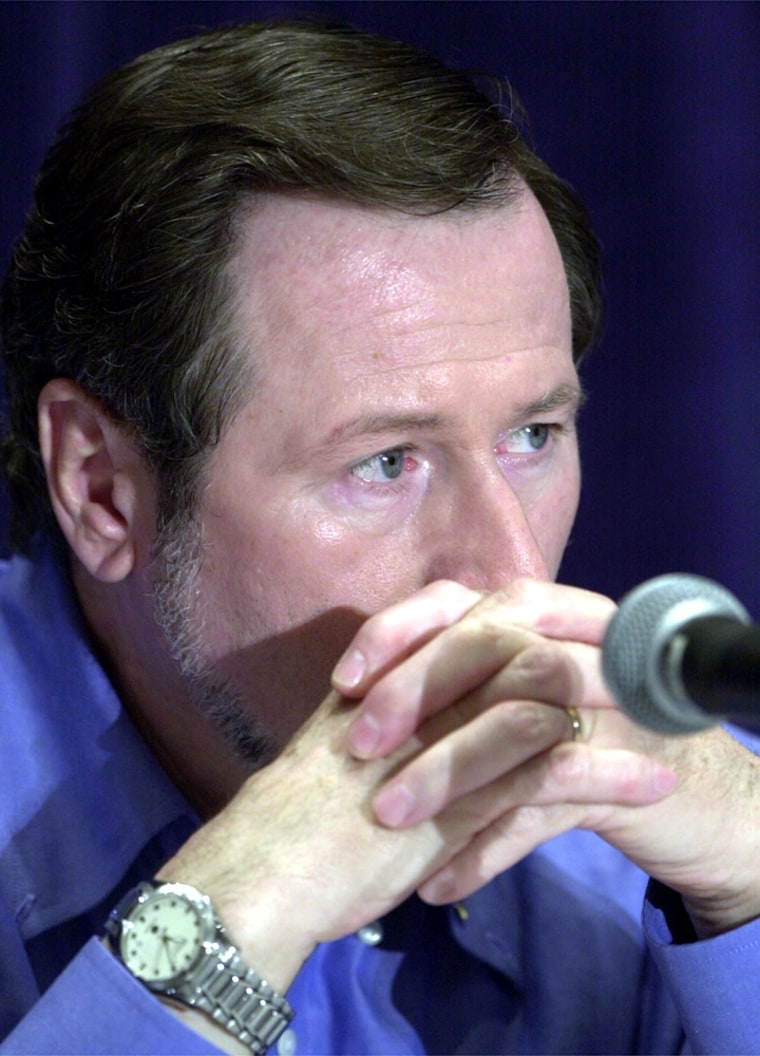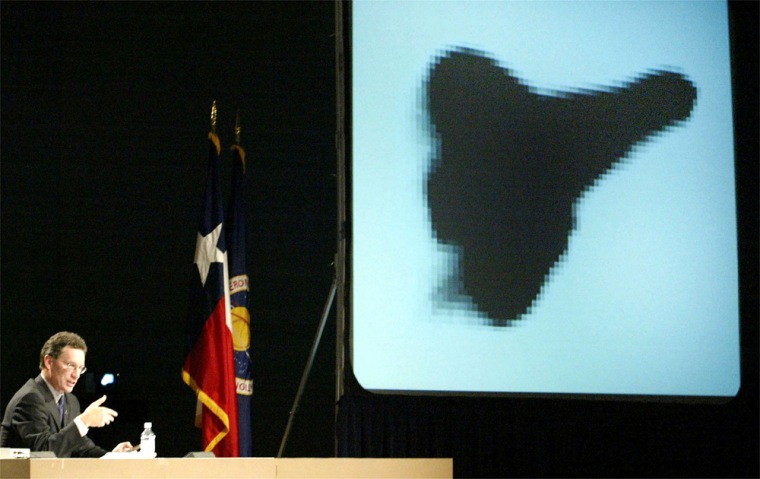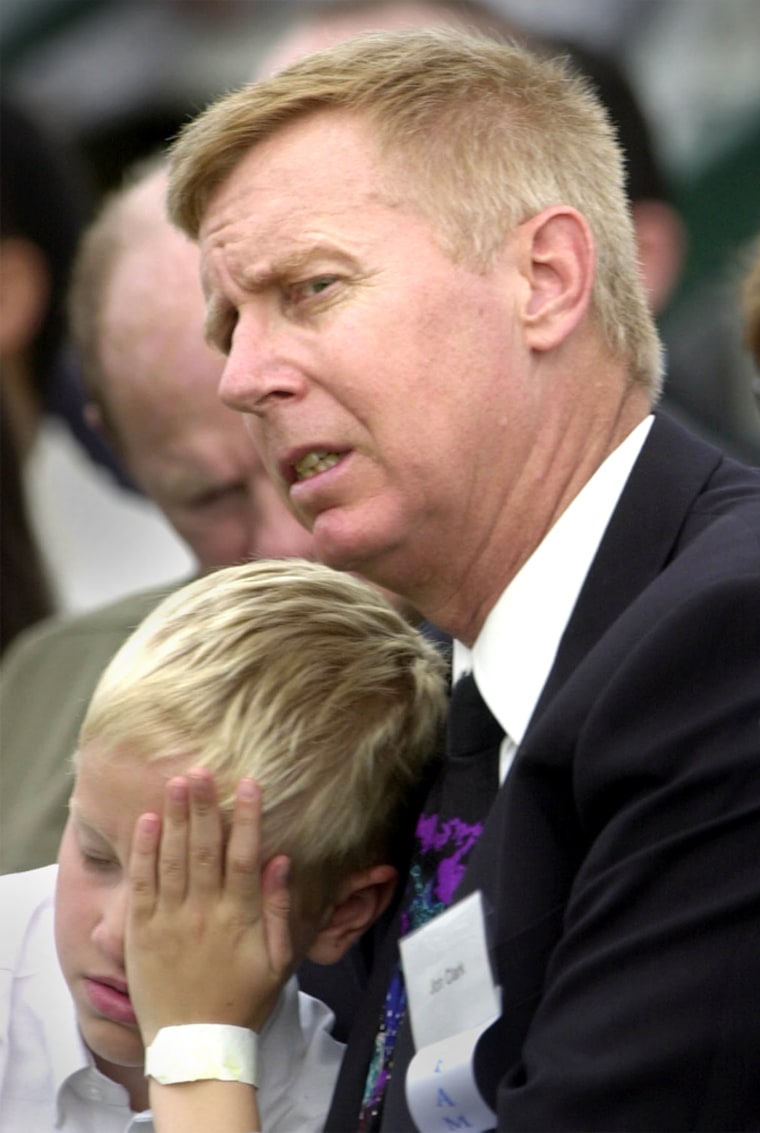For the rest of time, these three men will be linked by the Columbia disaster, strangers thrown together by that awful Saturday morning in February.
The accident has altered their lives forever: NASA’s most visible persona during those dreadful first days, a scientist who would dig into the cause of the accident, the grieving husband of one of the two women on the flight.
Ron Dittemore, the space shuttle program manager who took the most dramatic public fall, remains emotionally scarred one year later. He left NASA and now holds a low-profile aerospace job in Utah.
Not a day goes by that he does not think about the mistakes he made during Columbia’s farewell flight.
The seven lost lives weigh heavily on him. After repeatedly delaying previous shuttle launches for all sorts of reasons, he wonders what it was that prevented him and others from seeing the risk in the piece of foam that broke off and hit the shuttle wing. “Why didn’t the hair stand up on your neck?” he asks himself.
Douglas Osheroff, the Nobel Prize-winning physicist who investigated the accident, still wonders if NASA can save itself.
He sensed from the start that the flyaway chunk of foam at liftoff likely doomed Columbia. But he forced himself to keep an open mind and followed the evidence, over six months, to that very conclusion.
The Stanford University researcher learned more about foam-shedding in a series of quick kitchen experiments than NASA ever learned in more than two decades of shuttle flight.
Dr. Jon Clark, still numbed at times by the pain of losing his wife and the mother of his son, uncomfortably straddles two worlds.
Clark is an insider, working for NASA as a neurologist. But ever since Laurel Clark and six other astronauts perished aboard Columbia, he feels more like an outsider as he pushes for cultural change within an agency that he sadly believes does not have what it takes to put humans on the moon or Mars.
Virtually everyone inside and outside the space program acknowledges that the Columbia tragedy, along with the investigation board’s condemnation of the lack of a national space vision, spurred President Bush into aiming for the moon.
“I would really love that to happen,” Clark says. “But I can tell you that it can’t happen without NASA fundamentally changing.”
An empty sky
The three men had no way of knowing on Feb. 1, 2003, that their lives would intersect.
Moments after 9 a.m. ET, Columbia shattered in the sky over Texas while streaking through the atmosphere toward Cape Canaveral, just another 16 minutes on top of a journey that had spanned 16 days.
NASA had safely pulled off all 111 of its previous space shuttle landings, despite a power unit on fire, a burst tire, periodic cross-country detours and, all too often, pockmarked bellies and wings from foam and other debris.
So until the moment communication ceased with Columbia during re-entry, hardly anyone was seriously worried about the foam strike to the ship’s left wing back on Jan. 16. And the few engineers who were worried never spoke up, at least not to anyone who could make a difference.
Most of the flight controllers in Houston had put the foam impact out of their minds as Columbia was zooming homeward. But the launch-day incident came rushing back, flooding their brains, as one shuttle sensor after another started going out of whack.
“Columbia, Houston, we see your tire pressure messages and we did not copy your last call,” Mission Control radioed.
“Roger,” replied Columbia’s commander Rick Husband. He started to say something that sounded like “Buh...” but was cut off. The time was 8:59 a.m.
That was the last anyone on the ground heard from Columbia.
Thirteen minutes later, one of the mission managers got a call on his cell phone from an off-duty colleague who was watching TV images of the flaming wreckage hurling to the ground. He walked over to flight director LeRoy Cain and gave him the horrible news.
Cain declared an emergency and issued a terse, bone-chilling order to his team: “Lock the doors.” All data were about to be impounded and no one was getting in or out.
A thousand miles away, at Cape Canaveral, the families of the seven Columbia astronauts waited along the runway. The twin sonic booms that herald a shuttle’s arrival never came, and at 9:16 a.m., the appointed touchdown time, the countdown clocks started ticking upward.
The sky was empty.
Dark news ... then the screams
Jon Clark, with his all his intimate knowledge about launches and landings, knew something was very wrong. He’d been listening to Mission Control’s commentary on the loudspeakers alongside the runway and was disturbed by the call to Columbia about the tire-pressure alarms and the commander’s truncated reply.
His brain went into high-speed analytical mode: The crew was probably going to have to bail out and his wife was in one of the worst spots, on the upper flight deck. By his count, she would be the fifth to jump and he was hoping that the three men on the lower deck would get out fast and make way for the four on top.
Clark says he was more worried about the guys downstairs dawdling than how his wife, a Navy captain and doctor, might respond. She had always been able to handle herself in a crisis and had made a lot of parachute jumps.
What was happening though, was unimaginable — even to him.
Descending at nearly 20 times the speed of sound in a bucking spacecraft, the astronauts could not have bailed out, least of all from 200,000 feet.
They never stood a chance.
Within a minute or a little more, it was all over. The Columbia and its seven souls were gone, hurled all over Texas and Louisiana.
Someone telephoned one of the astronaut family escorts as they all waited at the landing strip, and everyone dashed to the SUVs that had brought them there and roared back under police escort, on the wrong side of the road, to astronaut quarters.
There, in a conference room, the wives, husbands and children of the astronauts were told that while there was no confirmation of fatalities, the accident was believed to be unsurvivable.
The screams were bloodcurdling.
President Bush later called the families to console them and then announced to the world that Columbia was lost and that all seven on board — Rick Husband, William McCool, Kalpana Chawla, Laurel Clark, Michael Anderson, David Brown and Israel’s first astronaut, Ilan Ramon — were dead.
Fights over the foam
A shell-shocked Dittemore appeared before the TV cameras in midafternoon and urged journalists not to rush to judgment about the foam impact.
“There are a lot of things in this business that look like the smoking gun but turn out not even to be close,” Dittemore said from Houston. Four days later, he insisted the foam was not to blame.

The very next day, once the accident investigators hit town, he acknowledged he was wrong to rule out anything so early in the game.
NASA Administrator Sean O’Keefe was outraged by Dittemore’s swift dismissal of the foam. He told him — and everyone else — to stop leaping to conclusions and let the investigators rule things out one by one. His biting criticism about the surge in “foamologists” echoed through the succeeding days and months.
O’Keefe says his reproach was aimed both at those who assumed the foam caused the accident and those, like Dittemore, who refused to believe it could.
It turned out that the suitcase-size section of foam insulation was the biggest piece ever to break off a shuttle fuel tank, and it slammed into the underside of Columbia’s left wing edge at more than 500 mph, 81 seconds after liftoff.
Shuttles had been struck before by foam and other debris, to no great consequence. But while viewed as a problem, little was ever done to stop the foam from breaking off. And there was no one bold enough to express fears about the wounded Columbia.
Even Jon Clark — a doctor not an engineer — was puzzled when he saw a reference to the launch-day foam strike as he read the Mission Control log notes during Columbia’s mission.
Everyone looked the other way when Clark offered to pinch-hit for some overworked doctors in Mission Control while Columbia — carrying his wife — was in orbit.
When he came across the foam note, it was the first he’d heard of it.
“Wow, that’s weird,” he thought.
Clark decided not to make a fuss or even delve further into it. It wasn’t his area of expertise. He avoided the subject while speaking to his wife in orbit. He didn’t want to worry her. Besides, the word was, it wasn’t significant.
Puzzling silence
Mission managers, grown accustomed to uneventful landings and under the flight schedule gun, dismissed the concerns of low-level engineers and did not seek spy satellite pictures of the damaged wing.
NASA’s top safety official, Bryan O’Connor, learned of the foam strike while Columbia was still in orbit. He was tipped off by a colleague who had a friend in the Pentagon that people there were surprised the space agency had not requested zoom-in pictures.
O’Connor, a retired Marine colonel and former shuttle commander working in Washington, did not have the military clearance to deal with the issue. So he passed off the problem to shuttle managers in Houston, and there it languished.
One year later, O’Connor is filled with regret and still trying to figure out why he, like so many others, never spoke up. He offered to quit after the accident, but O’Keefe urged him to stay and make the shuttle program safer.
O’Connor has since adjusted his threshold level downward for creating stinks.
“Does that mean I’ll catch everything? No,” he says. “I’m not smart enough and I’m not bold enough to tell anybody that from now on, based on what I learned from this accident, there will be no more accidents because I’ll catch everything.”
Curses and goodbyes
As Dittemore briefed the world on NASA’s second shuttle accident in 17 years, Osheroff, the physicist, was driving through the Santa Cruz Mountains in Northern California to his favorite dim sum restaurant. He and his Chinese-born wife made the trip to Ming’s of Palo Alto for brunch nearly every Saturday.
Neither had listened to the news before leaving home, and Osheroff was puzzled when he turned on the car radio and heard a NASA news conference in progress. The radio announcer finally came on and summarized what had happened: The shuttle Columbia had broken up on re-entry and, perhaps not so coincidentally, a chunk of foam had fallen off the fuel tank during launch 16 days earlier and hit the left wing.

Osheroff cursed. He knew enough about the brittle graphite leading edge of the shuttle wing to know that the foam had likely created catastrophic damage. He had no way of knowing then that within a month he’d be called to join an investigation into the catastrophe.
The military-saturated investigation board needed scientific heavyweights, and its chairman, retired Navy Adm. Harold Gehman sought out Osheroff and fellow physicist Sally Ride, the first American woman in space. John Logsdon, director of George Washington University’s space policy institute, also got an invitation, and the number of board members swelled to a final 13.
As Dittemore grimly answered reporters’ questions and Osheroff listened in disbelief across the country, Clark was on a NASA jet flying back to Houston from Cape Canaveral with the other astronaut families.
The newly widowed flight surgeon was playing the card game War with son Iain, then 8, in hopes of distracting the boy. Just as the plane passed over the Texas-Louisiana border, where most of the wreckage had fallen, the child froze and instead of looking at his cards, raised a hand and moved it back and forth.
“Iain, what are you doing?” Clark asked.
“I’m waving goodbye to Mommy,” he said. “I felt her.”
Already, law officers and volunteers were combing the swamps and woods below, looking for pieces of the shuttle.
By the time the search officially ended in April, 85,000 pounds of debris — and nearly 85,000 individuals pieces — were recovered, including 845 pieces of the foam-damaged left wing. Thirty-eight percent of the shuttle was retrieved, as far west as Littlefield in West Texas and as far east as Fort Polk in Louisiana, south of Shreveport.
In all, more than 25,000 people took part in the recovery operation, covering an area almost as big as Connecticut. The cost to the Federal Emergency Management Agency was more than $305 million.
The right stuff?
Osheroff says he’s been thinking a lot, since the investigation board’s report came out in August, about how and why NASA’s bizarre culture evolved — not just in its approach to safety issues but its lack of curiosity. The only conclusion he can reach is, “This is what happens to an organization that simply doesn’t have the money to do what it wants to do safely.”

Dittemore, the former shuttle program manager, refuses to discuss NASA’s culture or whether his departure was essential. He doesn’t care to rehash the past, saying he prefers looking to the future.
He is, however, one of the few to readily accept full responsibility for the tragedy.
“It doesn’t get any easier as the time passes, because I still focus on seven families, and what did we miss to allow such a tragedy to occur,” Dittemore says.
While progress is being made on the technical front for the grounded shuttle fleet’s return to flight, perhaps as early as this fall, Clark says not enough is being done to fix NASA’s crucial cultural issues.
“How do I know that? I have eyes and ears. People come to me,” he says. “I’m not talking about little petty things. I’m talking about fundamental issues, about not listening.”
Clark goes on. “Look, let’s face this. I mean, if you read the Challenger reports and you read the Columbia ones and just change ’O-ring’ for ’foam,’ you see there’s this underlying concern there. ... It can’t be one of those things where dissension is suppressed.”
It’s important to be open and frank about the crew survivability issues, Clark says, especially considering a new spaceship is on the horizon and lifesaving improvements could be made.
The president’s new space initiative calls for the three remaining space shuttles to be retired in 2010 and a crew exploration vehicle to eventually take their place, first ferrying crews to the international space station and then evolving into a spacecraft for the moon and, ultimately, Mars.
Scott Hubbard, the director of NASA’s Ames Research Center in California who served on the Columbia accident board, was hoping for a new direction for the space agency. But he never imagined it would come so soon, within a year of the disaster.
“It’s the best legacy the crew could possibly have, to see what they lived and died for to be now carried forward in a new policy that really commits to exploration beyond low-Earth orbit,” Hubbard says.
NASA is going to need adequate money, though, to ask all the necessary questions to pull it off, Osheroff says.
“It’s like a kid in school who asks why is the sky blue and how do homing birds home?” he explains. If he doesn’t get answers to his questions, maybe he is discouraged from asking them.
“It’s the same stuff. You can’t continue to ask questions for which you don’t get answers for a long time. After a while, you stop asking those questions.”
Osheroff’s guess is that NASA will start asking questions. His own question, though, is whether NASA will keep it up.
